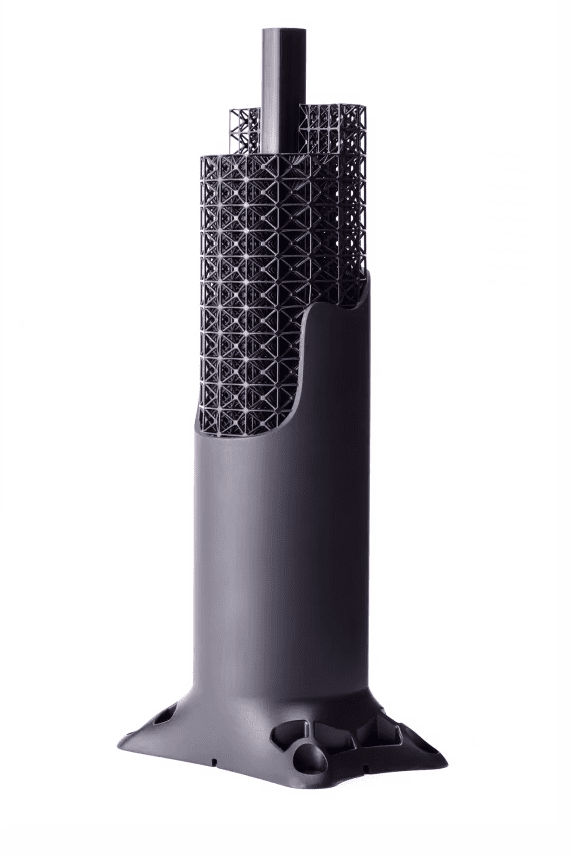Fused deposition modeling (FDM), sometimes called fused filament fabrication (FFF), is a manufacturing process that has been around since the advent of additive technology. S. Scott Crump developed and commercialized this process in the late 1980s and early 90s after he founded Stratasys, and the FDM process has since become synonymous with how many people think about 3D printing today.
FDM 3D printers work by extruding thermoplastic filaments through a heated nozzle and applying layers of molten plastic onto a build platform. Once the layers cool, the part is complete.
Manufacturing with FDM technology is often simpler and more straightforward than using newer additive technologies like Carbon Digital Light Synthesis (DLS), stereolithography (SLA), or HP MultiJet Fusion (MJF) because it involves only heat and plastic — no vats, resins, or ultraviolet lights required.
Cutting-edge additive manufacturing technologies like DLS and MJF are exciting and promise new possibilities — but that doesn’t necessarily mean they’re the best fit option for every project. Oftentimes, product teams — drawn to the novelty and excitement of new 3D printing technology — overlook the benefits of legacy additive manufacturing technologies like FDM. However, in many cases, FDM will actually produce the best results.
Why choose legacy additive over new 3D printing technology?
Engineers should consider using legacy additive over new 3D printing technology because these methods have withstood decades of battle-testing. Since FDM has been in widespread use for decades it has a more robust knowledge base than newer technologies. Because they’re comfortable with the process of FDM and aware of its limitations, engineers and product teams can build with confidence and try out innovative designs.
In terms of material options, legacy additive outpaces various 3D printing technologies. FDM is compatible with a wide range of thermoplastics — from ABS to nylon to TPU — that have been tested, regulated, and well-received for many years. In fact, engineers who are accustomed to other plastics manufacturing processes, such as injection molding, can easily use an FDM machine to build a part from the exact same material they would normally use.
Comparatively, younger 3D printing technology materials are still being evaluated, and in five or six years product teams might discover that the material they used for their last production run wasn’t the best choice for ensuring long-term performance. Engineers can eliminate this potential pain point altogether by using legacy additive.
What’s more, FDM is the only additive technology that’s compatible with ULTEM® (PEI), the only high-performance thermoplastic that’s been approved for use in the aerospace industry. By using legacy additive, engineers can pursue more challenging, innovative use-cases in strictly regulated industries.

Another factor promising broader design and engineering flexibility in the FDM process is the physical size of FDM machines and their workspaces. FDM machines are generally bigger than new 3D printing technologies, which enables the creation of larger parts. MJF, SLA, and DLS machines all offer smaller workspaces, thus restricting the size of manufacturable parts.
Finally, FDM is generally more reliable than new 3D printing technology when it comes to 3D rapid prototyping. This process is fast, reliable, efficient, and ideal for creating multiple prototypes without driving up costs.
Choosing between additive manufacturing technologies
These key advantages notwithstanding, legacy additive does have its drawbacks. For example, FDM isn’t generally recommended for consumer-facing products or applications for which a clean surface finish is required since filament extrusion often leaves behind noticeable texture differences on the part. It can be also challenging to create tiny features or lattices using FDM. In situations like these, it would make more sense to leverage a newer 3D printing technology.

When deciding between additive manufacturing technologies, it’s best to consider size and geometry first. These factors will narrow down the pool of prospective processes considerably. If an engineer wants to print a large plastic part, they can rest assured that FDM is likely among the best options for manufacturing.
If an engineer wants to print a part that’s more modest in size, they can consider a wider range of processes, while keeping in mind that Carbon DLS is only recommended for parts smaller than the palm of one’s hand. If an engineer wants to print a consumer-facing product with intricate details or a high resolution, they’re better off narrowing their evaluation down to DLS, SLS, or MJF.
After size and shape have been taken into consideration, engineers and product teams can get more granular and start thinking about materials, cost, production speed and volume, and more.
Build better parts with expert advice and guidance
When it comes to additive manufacturing technologies, newer isn’t always better. FDM was developed over thirty years ago, but it still ranks among the top additive manufacturing technologies for rapid prototyping and manufacturing large parts.
Plus, it outpaces various 3D printing technologies when it comes to available materials. Still, there are instances in which new 3D printing technology offers something that legacy additive cannot. It’s up to product teams to do their due diligence to ensure they’re selecting the best-fit additive technology for their given project.

Our team at Fast Radius has extensive experience with FDM and newer additive technologies. We can help you choose the right process for your project and provide design for manufacturing (DFM) support for all the technologies we offer. Check out some of the additive manufacturing product development and design work we’ve done for customers like Satair, Colgate-Palmolive, and Steelcase. We’ll help take your project to the next level. Contact us today to get started.
For more additive technology insights, check out the related articles in the Fast Radius learning center.
